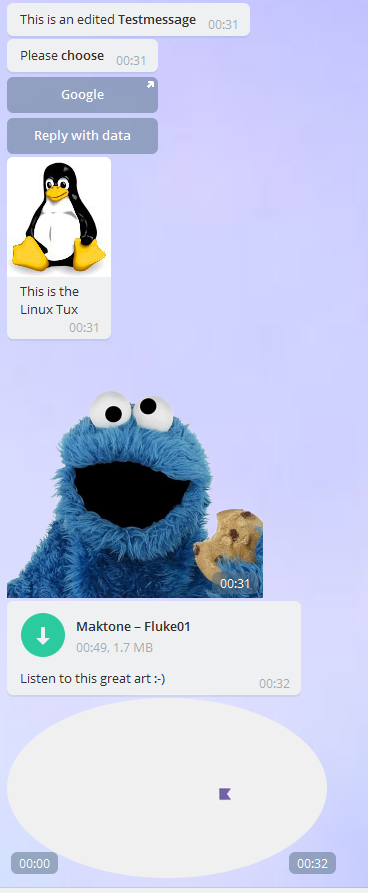A very easy to use Qt library for Accessing the Telegram Bot Api.
The Telegrambot library gives you multiple possibilities to receive messages which was sent to your bot
Message Pulling
The Message pull system connects to Telegram Server and pull for new messages:
- If a new Message is available, the Telegram Server push a new message directly over this connection to us,
then the Telegrambot processes this message(s) and send for every message a SIGNAL to the outside world. - If the Telegrambot don't receive a message in a given time, the pull system disconnects from the telegram server.
- This Process repeats endless until the user call stopMessagePulling().
Advantages over Webhook:
- No administrative Task needed to make it work
- Client only need the possibility to connect to a remote server
- No Certificate needed
- No open Port needed
- No NAT port forwarding needed (if client is in NAT-Network)
Disadvantages over Webhook:
- Only one simultaneously connection to telegram to handle messages
Here an example
#include <QCoreApplication>
#include "telegrambot.h"
int main(int argc, char** argv)
{
QCoreApplication a(argc, argv);
TelegramBot bot("APIKEY");
QObject::connect(&bot, &TelegramBot::newMessage, [](TelegramBotMessage message) {
qDebug("New Message from: %s %s (%s) -> %s",
qPrintable(message.from.firstName),
qPrintable(message.from.lastName),
qPrintable(message.from.username),
qPrintable(message.text));
});
bot.startMessagePulling();
return a.exec();
}Message Polling (Webhook)
The Webhook system tells the Telegram Server to call a secure public Web Url to deliver the user message.
To make this possible the public url needs a valid certificate, either a valid public accpeted one or a self signed one.
Here an easy example installation instruction which should work nearly for all kinds of setups (including NAT):
- First we need a public domain, so let us make one using this awesome nip.io service: telegram.our ip address.nip.io
- Now we generate an ssl cert for this domain using the following command line (we need the openssl tool for it):
openssl req -newkey rsa:2048 -sha256 -nodes -keyout telegram.key -x509 -days 365 -out telegram.crt -subj "//C=DE\CN=telegram.[our ip address].nip.io" - Put the generated files (telegram.key and telegram.crt) into the working directory of your application.
- If in Nat, forward external port 8443 to port 8443 on local PC.
Then use the following Qt Code:
#include <QCoreApplication>
#include "telegrambot.h"
int main(int argc, char** argv)
{
QCoreApplication a(argc, argv);
TelegramBot bot("APIKEY");
QObject::connect(&bot, &TelegramBot::newMessage, [](TelegramBotMessage message) {
qDebug("New Message from: %s %s (%s) -> %s",
qPrintable(message.from.firstName),
qPrintable(message.from.lastName),
qPrintable(message.from.username),
qPrintable(message.text));
});
bot.setHttpServerWebhook(8443, "telegram.crt", "telegram.key");
return a.exec();
}The Tegrambot library gives you also the possibility to communicate with chats.
Here is an example which should explain the basic use cases:
#include <QCoreApplication>
#include "telegrambot.h"
int main(int argc, char** argv)
{
QCoreApplication a(argc, argv);
TelegramBot bot("APIKEY");
QObject::connect(&bot, &TelegramBot::newMessage, [&bot](TelegramBotUpdate update) {
// only handle Messages
if(update->type != TelegramBotMessageType::Message) return;
// simplify message access
TelegramBotMessage& message = *update->message;
// send message (Format: Normal)
TelegramBotMessage msgSent;
bot.sendMessage(message.chat.id,
"This is a Testmessage",
0,
TelegramBot::NoFlag,
TelegramKeyboardRequest(),
&msgSent);
// edit text of sent message (Format: Markdown)
bot.editMessageText(message.chat.id,
msgSent.messageId,
"This is an edited *Testmessage*",
TelegramBot::Markdown);
// send message (Format: HTML, Keyboard: Inline (2 Rows, 1 Column), Reply to Message: Yes)
bot.sendMessage(message.chat.id,
"Please <b>choose</b>",
0,
TelegramBot::Html,
{
// Keyboard
{
TelegramBot::constructInlineButton("Google", "", "https://www.google.com"),
}, {
TelegramBot::constructInlineButton("Reply with data", "MYDATA1"),
}
});
// send photo (file location: web)
bot.sendPhoto(message.chat.id,
"https://www.kernel.org/theme/images/logos/tux.png",
"This is the Linux Tux");
// send audio (file location: local)
bot.sendAudio(message.chat.id,
"Maktone - Fluke01.mp3",
"Listen to this great art :-)",
"Maktone",
"Fluke01");
// send video chat note (file location: QByteArray)
QFile file("testvideo.mp4");
file.open(QFile::ReadOnly);
QByteArray content = file.readAll();
bot.sendVideoNote(msgSent.chat.id, content);
// send sticker (file location: telegram server)
bot.sendSticker(message.chat.id, "CXXXXXXXXXXXXXXXXXXXXXXX");
});
bot.startMessagePulling();
return a.exec();
}This example produces the following Telgram messages:

The library provides four different opportunities for sending a file to telegram:
- Web: just provide an web link as string
- Local file: just provide a local file path as string
- QBytearray: just call with a QBytearray which contains the data (The library also try to detect its content type!)
- Telegram Server: just call with an telegram file id as string
Note: file uploades are handled asynyron!
A possible use case for all types are also available in the example above.
In Addition the Library contains a message routing system.
This system allows you to route any kind of message to your own functions (using a QDelegate)
The following Code Example demonstrate this message routing, by handing the first /start-message a user send to a bot:
#include <QCoreApplication>
#include "telegrambot.h"
int main(int argc, char** argv)
{
QCoreApplication a(argc, argv);
TelegramBot bot("APIKEY");
bot.messageRouterRegister("/start", {[&bot](TelegramBotUpdate update) {
bot.sendMessage(update->message->chat.id, "Hi, i'am a Test bot");
return true;
}}, TelegramBotMessageType::Message);
bot.startMessagePulling();
}Additional Notes:
- The example above only handles the /start message all other messages send to the bot are silently ignored.
- The message Router match field depends on the received message type:
| Message Type | Fieldname |
|---|---|
| TelegramBotMessageType::Message | Message.text |
| TelegramBotMessageType::EditedMessage | Message.text |
| TelegramBotMessageType::ChannelPost | Message.text |
| TelegramBotMessageType::EditedChannelPost | Message.text |
| TelegramBotMessageType::InlineQuery | InlineQuery.query |
| TelegramBotMessageType::ChosenInlineResult | ChosenInlineResult.query |
| TelegramBotMessageType::CallbackQuery | CallbackQuery.data |
The telegrambotlib-qt depends on QDelegate which are allready included as submodule,
so we have to make sure that the submodules are checked out, too:
git clone --recursive <path>Or if repo allready exists
git submodule update --init --recursiveJust add the following to your Qt-Project file:
include(telegrambotlib-qt.pri)Include project syntax:
#include "telegrambot.h"
Note: The make install installation pathes, are printed to you during qmake!
qmake telegrambotlib-qt.pro
make
make install
add the following to your pro file:
LIBS += -ltelegrambotlib-qtInclude project syntax:
#include <telegrambotlib-qt/telegrambot.h>
The telegrambotlib-qt licence is a modified version of the LGPL licence, with a static linking exception.
